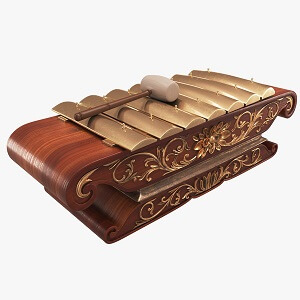Saron
 The saron barung is a metallophone idiophone of the Javanese people of Java, Indonesia. It is a melodic instrument that is part of the Javanese gamelan. The iron gamelan to which the instrument pictured on this page belongs has eight saron barung--four for each of the set’s tuning systems, laras sléndro and laras pélog.
The saron barung is a metallophone idiophone of the Javanese people of Java, Indonesia. It is a melodic instrument that is part of the Javanese gamelan. The iron gamelan to which the instrument pictured on this page belongs has eight saron barung--four for each of the set’s tuning systems, laras sléndro and laras pélog.
The saron barung (‘saron’ for short) is a one-octave metallophone with nearly rectangular keys (wilah) resting over a box resonator (rancakan kijingan). The steel keys on the demung pictured here are made from recycled leaf springs salvaged from trucks. Bronze and brass can and often are used for saron keys (see panerus). Holes for anchoring the keys on its casing are drilled at one-quarter of a key’s total length from each end, which are nodal (dead) points in the mode of vibration for rectangular keys. The keys rest on the top edge of the resonator’s sideboards, separated from it by cube-shaped cushions made of folded rattan (see detail photo). The keys and their cushions are anchored in place with pins (made from nails) that run through the holes in the keys and the cushions beneath them into the wooden sideboard. One hammer-shaped wooden beater (tabuh) is used to strike the keys.
Kunst argues that a saron is depicted in the reliefs of the 8th century CE Borobudur temple, but the image is vague and the identification questionable. It could be argued indirectly that Majapahit-period (14th and 15th centuries CE) ensembles included saron because some archaic Balinese ensembles, which might be viewed as Majapahit inheritances, have them. The most archaic (pre-16th century) Javanese gamelans in existence (gamelan monggang and gamelan kodhok ngorek) do not include saron, although it is known that two saron were added to one of them in the mid-18th century (Vetter). The gamelan sekati, generally dated to the beginning of the 16th century and still used today, do include saron, so we can say with certainty that the instrument goes back at least to the 1500s CE. However, in all likelihood, the instrument predates that era.